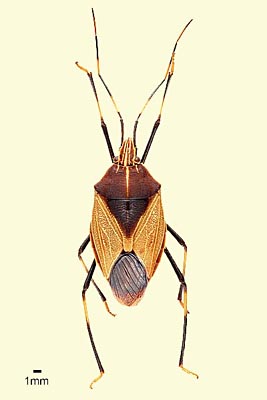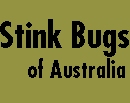
Poecilometis Dallas, 1851

|
|
Photo © Emma Betts, Australian Museum |
Type species:
Halys strigata Westwood, 1837 by subsequent designation.
Number of Australian species:
Fifty.
Extralimital Distribution:
Australian Region - New Zealand, Papua New Guinea.
Australian Distribution:
Temperate, arid, tropical and subtropical regions; New South Wales, Northern Territory, Queensland, Western Australia, South Australia, Victoria and Australian Capital Territory.
Biology:
Unknown.
Host(s):
Poecilometis alienus associated with Callitris preissi Miq. [CUPRESSACEAE] Native Pine, Eucalyptus sp. [MYRTACEAE].
Poecilometis australasiae associated with Eucalyptus sp. [MYRTACEAE].
Poecilometis darwini darwini associated with Mimosa pigra L. [MIMOSACEAE].
Poecilometis fuscescens associated with Acacia decurrens Willd. [MIMOSACEAE], Callitris preissi Miq. [CUPRESSACEAE] Native Pine, Citrus sp. [RUTACEAE], Codonocarpus cotinifoliud (Desf) F.Muell [GYROSTEMONACEAE], Eremophila freelingii F.Muell. [MYOPORACEAE], Thryptomene maisonneuvei F.Muell. [MYRTACEAE], Vitis vinifera L. [VITACEAE] Grape.
Poecilometis mimicus associated with Eucalyptus camaldulensis Dehnh. [MYRTACEAE] River Red Gum, Melaleuca sp. [MYRTACEAE].
Poecilometis nigriventris superbus associated with Eucalyptus camaldulensis Dehnh. [MYRTACEAE] River Red Gum.
Poecilometis spenceri associated with Eucalyptus camaldulensis Dehnh. [MYRTACEAE] River Red Gum.
Poecilometis strigatus associated with Citrus reticulata Balnco [RUTACEAE] Mandarin, Tangerine, Eucalyptus goniocalyx F.Muell. ex Miq. [MYRTACEAE], Grevillea robusta R.Br. [PROTEACEAE] Silky Oak, Leptospermum coriaceum (Miq.) Cheel [MYRTACEAE], Rubus idaeus L. [ROSACEAE) Raspberry, Rubus sp. [ROSACEAE], Syrinda volgaris L. [Oleaceae].
Poecilometis vallicola associated with Eucalyptus camaldulensis Dehnh. [MYRTACEAE] River Red Gum.
Diagnosis:
Colour
Texture
Densely and uniformly punctate, dorsally and ventrally.
Vestiture
Glabrous.
Structure
Body - Elongate-ovoid, dorsally convex. Length 7.7 mm -17.5 mm; width 4.3 mm -13.1 mm.
Head - Triangular to subtriangular, porrect (clypeus horizontally orientated) or moderately dorsoventrally orientated, shorter or longer than pronotum; jugae shorter or equal to clypeus; apically pointed, laterally carinate; antennifer processes present or absent; four or five antennal segments, first antennal segment longer than the distance between the eyes, inserted into head below the mid-height and above the ventral margin of the eyes; bucculae longate (posteriorly beyond antennifers); vertex cross-sectional shape flattened or convex; labium extending between the middle coxae and the fourth abdominal sterna, first labial segment longer than buccuclae; eyes not stylate, directed laterally.
Pronotum - Calli present; anterior lobe surface flat or excavate; humeral angles angulate to rounded; lateral margins carinate; anterolateral margins simple or crenulate and straight, sinuate or concave; posterolateral margins straight, sinuate or convex; posterior margin straight, concave, sinuate or convex.
Scutellum - Triangular, apex narrowly or broadly rounded and sometimes bifid; lateral calli and medial callus present or absent.
Thoracic sterna - Prosternum flat or shallowly sulcate; mesosternum with a low raised keel; metasternum flat.
External efferent system - Evaporative scent gland covering between half and all of the metepisternum; peritreme elongate.
Hemelytra - Macropterous, longer than abdomen; membrane veins linear and mostly subparallel.
Legs - Fore tibia rounded or sulcate.
Abdomen - Connexiva visible or obscured by hemelytra; laterotergites with or without posteriorly directed spines.

